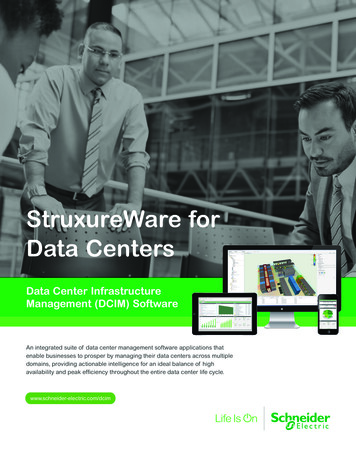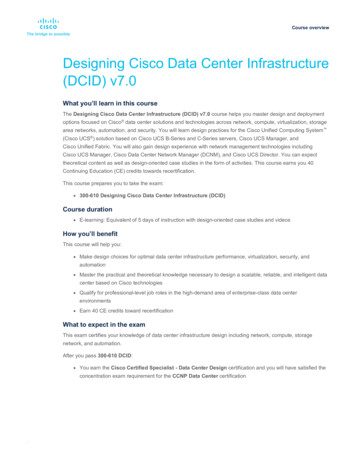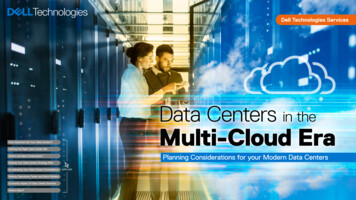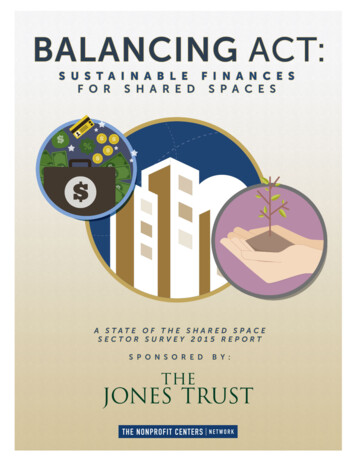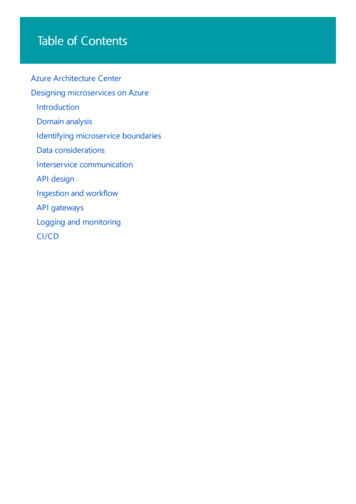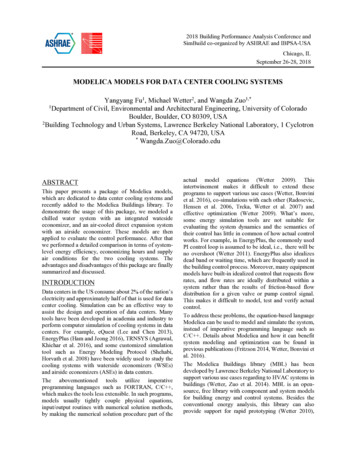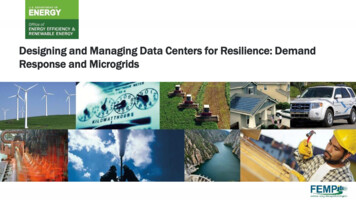
Transcription
Designing and Managing Data Centers for Resilience: DemandResponse and MicrogridsU.S. DEPARTMENT OF ENERGYOFFICE OF ENERGY EFFICIENCY & RENEWABLE ENERGY1
Webinar Logistics This webinar is being recorded. The Q&A portion will not bemade publicly available. Your phone will be muted throughout the webinar. Enter any questions in the Question Box throughout the webinar. Instructions to take the quiz will be provided at the end ofwebinar. Slides will be sent out afterwards to those who attend the entirewebinarU.S. DEPARTMENT OF ENERGYOFFICE OF ENERGY EFFICIENCY & RENEWABLE ENERGY2
PresentersU.S. DEPARTMENT OF ENERGYRachel ShepherdDOE-FEMPData Center Program LeadDale Sartor, P.E.Lawrence Berkeley LaboratoryStaff Scientist/EngineerRish GhatikarElectric Power Research InstituteProject Lead, Senior ProgramManagerBruce Myatt, P.E.ARUPData Center Business LeadMukesh KhattarElectric Power Research InstituteTechnical Executive, Data CentersRussell Carr, P.E.ARUPTechnical LeadOFFICE OF ENERGY EFFICIENCY & RENEWABLE ENERGY3
Agenda IntroductionWhat does resilience mean for data centers?Resilience and efficiencyIntro to advanced strategies for data center resilienceData center demand response (DR)Data center microgridsNext steps toward a resilience strategySummaryResourcesQ&AU.S. DEPARTMENT OF ENERGYOFFICE OF ENERGY EFFICIENCY & RENEWABLE ENERGY4
Resilience – What is it?The ability to prepare for and adapt to changing conditions and withstand and recoverrapidly from disruptions. Resilience includes the ability to withstand and recover fromdeliberate attacks, accidents, or naturally occurring threats or incidents.* Very large-scale events (VLSEs)with potentially catastrophicimpacts pose increasing risk.*– Can be man-made (cyber,electromagnetic pulse) or natural(hurricanes, wildfires) Frequency and severity of VLSEsmay continue to increase with“malicious intent” and “climaterisks.”* Presidential Policy Directives PPD 8 & 21 2013; GridModernization Laboratory Consortium 2017; FERC 2018U.S. DEPARTMENT OF ENERGYOFFICE OF ENERGY EFFICIENCY & RENEWABLE ENERGYThe number bars, left axis, type colors, and annual cost right vertical axis of U.S. billion-dollar disasters from 1980-2018Source: NOAA5
Challenges to Electric System ResilienceHigh-Magnitude EarthquakeNaturalHazardsGeomagnetic Disturbance (GMD) - Severe Space WeatherHurricanes, Wildfires, Other Severe Weather EventsElectromagnetic Pulse (EMP), Nuclear/Chem/BioManmadeHazardsCyber TerrorismCoordinated Physical AssaultOtherInterruptionsAccidents, Fuel Supply Unavailability, Public Safety Power ShutoffSource: Electric Power Research InstituteU.S. DEPARTMENT OF ENERGYOFFICE OF ENERGY EFFICIENCY & RENEWABLE ENERGY6
Three Complementary Pathways to Improving ResilienceWithstandAssess and RecoverSource: Electric Power Research InstituteU.S. DEPARTMENT OF ENERGYOFFICE OF ENERGY EFFICIENCY & RENEWABLE ENERGY7
What is Data Center Resilience?Reliability How often a component or system suffers an outage or fails, e.g., MTBFAvailability How much time power and cooling is available for IT operationsResilience Above plus ability to withstand extreme, system-wide events with managedrecovery Reaches beyond the data center, e.g., ensures a durable upstream fuel supplychain Sustains delivery of the most critical end servicesU.S. DEPARTMENT OF ENERGYOFFICE OF ENERGY EFFICIENCY & RENEWABLE ENERGY8
Critical Missions Demand High Resilience Data centers are already sited, designed and operated for highreliability. High availability of power, cooling, networks & applications Utility & Grid Independence– Uninterruptible power supplies (UPS), on-site generation, e.g., dieselgenerators and thermal storage are commonly used.U.S. DEPARTMENT OF ENERGYOFFICE OF ENERGY EFFICIENCY & RENEWABLE ENERGY9
Mission Critical Power Availability Redundant electrical system, e.g.,2N Dual Path Power – Grid andUPS/GeneratorImage Source: Aruba S.p.AU.S. DEPARTMENT OF ENERGYOFFICE OF ENERGY EFFICIENCY & RENEWABLE ENERGY10
Mission Critical Cooling Availability Redundant chilled water system May have redundant watersupplyU.S. DEPARTMENT OF ENERGYOFFICE OF ENERGY EFFICIENCY & RENEWABLE ENERGY11
Data Center Availability: Tier Classifications Tier 1 Non-redundant capacity components, single uplink and servers Tier 2 Tier 1 redundant capacity components Tier 3 Tier 2 dual-powered equipment and multiple uplinks Tier 4 Tier 3 all components are fully fault-tolerant and dual-powered,including uplinks, availability storage, chillers, HVAC systems, servers, etc.U.S. DEPARTMENT OF ENERGYOFFICE OF ENERGY EFFICIENCY & RENEWABLE ENERGY12
What Tier Is Best? Carefully evaluate applications: What is really needed?– Not all data center applications are critical, especially for a short interruption. Higher tiers add cost, complexity– Higher energy cost due to redundant systems operating in parallel at low load Tiers don’t guarantee availability– Can still have fuel contamination, broken fuel or water pumps, etc.– Slow breaker can turn brief outage into a data center crash Many examples of data centers without redundant systems, UPS, generation and evencompressor-based cooling– National lab HPCsResilience strategies can be different– Data centers can have low-tier availability but still be resilient – e.g., if they can “fail over” or transfer ITload to another facility unaffected by large-scale events.– More diversity in location and power/fuel supply greater resilience.U.S. DEPARTMENT OF ENERGYOFFICE OF ENERGY EFFICIENCY & RENEWABLE ENERGY13
Beyond Tiers: Mission Critical Network & Application AvailabilityReliability is often not about a single facility. Networking and failover among multiple data centers can be very cost effective“Availability zones” feature one or more data centers linked in a given geographic region to allowreplication of applications and data across physically separate data centers. Failure of any onedata center leaves up-to-date copies or “instances” of those services available at other datacenters. Parallel data processing IT/data failover from one DC toanother Other forms of networkedredundancy (asynchronous, cloud)Image Source: Amazon Web ServicesU.S. DEPARTMENT OF ENERGYOFFICE OF ENERGY EFFICIENCY & RENEWABLE ENERGY14
Can Resilience Be Synergistic With Efficiency? Efficiency is a resilience strategy, but EE and resilience can sometimesbe in tension. Strategies that boost efficiency can support resilience:– Smart air management - optimizing fan and cooling energy while improving reliability– Back-up cooling and generation can be minimized, given lower demand– Wider environmental envelopes (w/more robust IT equipment) allow for greaterefficiency and continued operation under compromised conditions, e.g., failure ofcompressor cooling.– Data Center Infrastructure Management (DCIM) can detect faults and provide earlywarning of potential problems. Can also help segregate loads by mission criticality. Simple systems (e.g., no compressor cooling) are generally more efficientand can be more reliable by reducing chances of human error.U.S. DEPARTMENT OF ENERGYOFFICE OF ENERGY EFFICIENCY & RENEWABLE ENERGY15
Beyond Redundancy: Two Advanced Resilience StrategiesDemand Response (DR)Microgrids Controlled changes in electric usage: Lower electricity use at times of highprices or when system reliability isjeopardized. Increase electricity use when prices arelow (e.g., batch loads). A bounded, local energy system capableof operating in isolation of the grid (e.g.,control and balancing of loads, gen andstorage). Multiple choices of mode, timing andmagnitude of load change Allows “arbitrage” among multipleresources Especially effective in conjunction withmicrogrids and variable supply resources. Given the high value of redundancy andavailability, data centers are a goodtarget for microgrids.U.S. DEPARTMENT OF ENERGYOFFICE OF ENERGY EFFICIENCY & RENEWABLE ENERGY Many components already deployed indata centers.16
Demand Response as a Strategy for Resiliencein Federal Data CentersRish Ghatikar and Mukesh Khattar, Electric Power Research Institute (EPRI)U.S. DEPARTMENT OF ENERGYOFFICE OF ENERGY EFFICIENCY & RENEWABLE ENERGY17
Context and Problem Statement: Demand Response (DR)Changes in electric usage by demand-side resources from their normal consumptionpatterns in response to changes in electricity price, incentives to lower electricity use at timesof high wholesale market prices or when system reliability is jeopardized.*1.Traditional DR has focused on managing peakelectricity usage.2.Increasing proliferation of variable renewablegeneration and advanced communications andcontrol technologies are enabling fast-respondingDR resources.3.Large energy consuming customers (e.g.,industrial facilities) commonly contract withsystem operators for interruptible electricity inexchange for lower electricity rates.Evolution of “FlexiblePower Use”* Federal Energy Regulatory Commission (FERC)U.S. DEPARTMENT OF ENERGYOFFICE OF ENERGY EFFICIENCY & RENEWABLE ENERGY18
Expanding Demand-Side Management Objectives1. Energy Efficiency programs reduce overall electricity consumption, generallyalso at times of peak demand.2. Price Response programs move consumption from times of high prices totimes of lower prices (real time pricing or time of use) – can addresstransmission distribution congestion management.3. Peak Shaving programs require more response during peak hours and focuson reducing peaks on high-system load days – can address transmission &distribution congestion management.4. Reliability Response (contingency response) requires the fastest, shortestduration response. Response is only required during power system “events.”This is new and slowly developing.5. Regulation Response continuously follows minute-to-minute commands(sub-minute telemetry) from the grid in order to balance the aggregatesystem load and generation. This is also very new and appears to be verypromising for certain loads.ShapeShiftShedShimmyAdapted from: Demand Response Spinning Reserve Demonstration Project, Consortium for Electric Reliability Technology, LBNL, Joseph Eto presentation October 19, l).U.S. DEPARTMENT OF ENERGYOFFICE OF ENERGY EFFICIENCY & RENEWABLE ENERGY19
Demand Response (DR) Context for Data CentersData Center DR opportunities: Facility infrastructure and IT infrastructureU.S. DEPARTMENT OF ENERGYOFFICE OF ENERGY EFFICIENCY & RENEWABLE ENERGY20
Demand Response (DR) Context for Data Centers Data centers sparingly participate in DR programs– Perceived risks (e.g., to availability) often given more weight than the value from participation– Most participation is from cooling loads, which in some private-sector data centers are decliningwith increased use of direct/indirect evaporative cooling of outside air without mechanical coolingand thus increased efficiency (PUE)*𝐏𝐔𝐄 𝐓𝐨𝐭𝐚𝐥 𝐅𝐚𝐜𝐢𝐥𝐢𝐭𝐲 𝐄𝐧𝐞𝐫𝐠𝐲𝐈𝐓 𝐄𝐪𝐮𝐢𝐩𝐦𝐞𝐧𝐭 𝐄𝐧𝐞𝐫𝐠𝐲 Data center participation is often focused on managing cooling loads– Example: Raise temperature set-points during the DR event. Leveraging IT equipment load is critical for long-term DR engagement efficacy.**– Computing power-capping technology developed by the industry.– Reducing computing load has synergistic effects on cooling loads* For example, a PUE 2.0 data center with 2 MW demand, uses 1 MW for non-IT load.** Ghatikar G., V. Ganti, N. Matson, & M. A. Piette, Demand Response Opportunities and Enabling Technologies for Data Centers: Findings from Field Studies, Aug. 2012. LBNL-5763E.U.S. DEPARTMENT OF ENERGYOFFICE OF ENERGY EFFICIENCY & RENEWABLE ENERGY21
DR Improves Resilience of Electric System and Data Center Site Data centers can effectively integrate DR best practices– Power capping reduces clock speeds during peak demand periods and so can improveresilience and lower electricity costs.ElectricSystemResilience DR is used now to improve electricity system resilience– Adaptation to increased over- and under-generation supply Raising or lowering temperature set-points and/or variable fan speeds– Can be even more important within a microgrid DRStrategiesDR can also be effective in improving local resilience:– Enable lowering of the infrastructure requirements, e.g., cooling system size Lower back-up capacity and costs due to lower demand– Extending the timespan of local resilienceLocalResilience Extends duration of islanded operationSlow-responding DR resources: Can support “withstand.”Fast-responding DR resources: Can support “withstand, survive, & recover.”U.S. DEPARTMENT OF ENERGYOFFICE OF ENERGY EFFICIENCY & RENEWABLE ENERGY22
Expanding DR to Support Local ResiliencekWkWDR-ModekWLower CapacityExpanded OperationsTimeData Center DemandData Center BackupBefore (“withstand”)U.S. DEPARTMENT OF ENERGYOFFICE OF ENERGY EFFICIENCY & RENEWABLE ENERGYTimeTimeData Center Backup for Resilience Under DR ModeAfter (“recover”)23
Data Center DR Strategies: IT InfrastructureEquipment,Function TypeDR Operational StrategyPower capping Limit clock speeds or otherwise slow process for less or non-essential loads.Load shifting or queuing IT jobs Use job scheduling techniques to reduce (or increase) load as desired.IT LoadUse built-in server power management capabilities for more aggressive load reduction.Use virtualization or techniques such as software-based power management to manageloads and power utilization (temporarily manage the available buffer)Use virtualization and migration technologies to move load to another facility on a lowerstressed gridImplement more aggressive network power managementU.S. DEPARTMENT OF ENERGYOFFICE OF ENERGY EFFICIENCY & RENEWABLE ENERGY24
Data Center DR Strategies: Facility InfrastructureEquipment,Function TypeDR StrategyIncrease temperature set points (e.g., from recommended to allowable range) Decreases load, and increases cooling efficiency including greater use of economizersCycle off or reduce power (e.g., speed control) to chillers, CRACs, fans, lights, UPS (e.g.,put in “eco” mode), transformers, etc. Modern UPS technologies and batteries provide additional value to support DR whilemaintaining back-up availability/reliabilityFacilityIntelligent linking of controls to respond to IT load reductions (rapid multiplier effect).InfrastructureEnergy storage (also can increase availability) Thermal Storage Electric Storage (including short duration strategic use of UPS to help utility balance loadsand frequency)Strategic use of emergency fossil-based generation When allowed by local air quality or environmental rules Run required testing when DR desiredU.S. DEPARTMENT OF ENERGYOFFICE OF ENERGY EFFICIENCY & RENEWABLE ENERGY25
Data Center DR Case Studies: Net Apps, Berkeley Lab, UC-Berkeley & SanDiego Supercomputing CenterData CenterDR IT, Facility Infrastructure and Network Migration Operational StrategiesShift/Queue data backups to storageNetAppTemperature set point adjustmentServer and CRAC units shutdownData Center ShutdownLoad migration - Homogeneous – IdlingLBNL 50BSDSC, UCB and LBNL 50BLoad migration - Homogeneous – ShutdownLoad migration – Heterogeneous - DecayKey Lessons DR effectiveness proven for many infrastructure and IT loads* No negative impacts (e.g., when recovering/recovered) High value to the grid and low operational impact on DCGhatikar G., V. Ganti, N. Matson, & M. A. Piette, Demand Response Opportunities and Enabling Technologies for Data Centers: Findings from Field Studies, Aug. 2012. LBNL-5763E.U.S. DEPARTMENT OF ENERGYOFFICE OF ENERGY EFFICIENCY & RENEWABLE ENERGY26
Field Test Results Correlation of CPU Utilization and PowerUC Berkeley (Mako) SDSC (Thresher) Load Migration StrategyDR Event: 12.30 pm to 5.10 pm (4hrs, 40mins)Spatial MigrationResults show a linear correlation between CPU utilization rate and power draw for dynamicincrease or decrease in CPU capacity reservation.Ghatikar G., V. Ganti, N. Matson, & M. A. Piette, Demand Response Opportunities and Enabling Technologies for Data Centers: Findings from Field Studies, Aug. 2012. LBNL-5763E.U.S. DEPARTMENT OF ENERGYOFFICE OF ENERGY EFFICIENCY & RENEWABLE ENERGY27
Resilience Enabling Technologies: DR Flexibility & ConnectivityThree Attributes of the Power System in a “No-Regrets” StrategySource: EPRI Report ID 3002007376, February 2016U.S. DEPARTMENT OF ENERGYOFFICE OF ENERGY EFFICIENCY & RENEWABLE ENERGY28
Advanced Technologies for Fast-Responding Energy Resources1.Reliability Response2.Regulation Response Faster responding DR resources (e.g., reliability andregulation response) are well-suited for shorternotification resilience events (e.g., flash floods). Advanced technologies (internal and external) play akey role in supporting resilience objectives.Secure external communication systems to grid operatorson emergency conditions.o Secure internal communications and control operationalstrategies to manage demand.o Interoperable communication technologies with electric grid(e.g., utilities, system operators) and internal systems (e.g.,cooling and IT systems)o Advanced technologies require supporting marketsfor electric system resilience (e.g., prevent a blackoutfrom undergeneration)U.S. DEPARTMENT OF ENERGYOFFICE OF ENERGY EFFICIENCY & RENEWABLE ENERGY29
Data Center Strategies for Local ResilienceData Center Local Resilience DR: Reduce non-criticaldemand. Fuel supply assurance. Equipment and servicehardening, and disasterrecovery planningStrategy Enhanced cybersecurity Strategies for robust andreliable network &communications Strategic digital & analogcapabilitiesPostResilience Event(Recover)DuringResilience ivityResilience DR: Aggressive reductionof non-critical demand. Local & networkredundancy Local supply: DER andmicrogridsAdapted from EPRI Reference Framework for Grid Resiliency.U.S. DEPARTMENT OF ENERGYOFFICE OF ENERGY EFFICIENCY & RENEWABLE ENERGY30
Open Questions: DR Programs to Resilience While benefits can be fairly quantified for local resilience, the same are not well-quantified for electricsystem resilience.– How do we value resilience for the system?– What are the cost and benefits of resilience? How do we show DR business value and test-cases during- and post-resilience periods?– When is N 1 or 2N 1 a better design choice?– Is network redundancy a better alternative for certain resilience triggers?– What metrics can we use for DR to provide resilience value? How do we value resilience for data centers since there is no one-size-fits-all resilience metric?– Attribute-based metrics: Measure components or properties of an asset or system that increase itsresilience– Performance-based metrics: Assess how an asset or system performs during a disruption. Can we answer some or all of these questions working with federal data centers owners andoperators. and field tests?U.S. DEPARTMENT OF ENERGYOFFICE OF ENERGY EFFICIENCY & RENEWABLE ENERGY31
Demand Response Summary Proven for a range of loads, purposes, and business-cases in datacenters More important with increasing variable generation capacity– Especially for microgrids with limited supply options/resources– Can withstand and adapt to over- and under-generation supply conditionsonsite and on the grid Continue to operate mission critical infrastructure originating fromresilience triggers by activating DR operational strategies. DR Operational strategies can also be effective in:– Lowering the infrastructure need for local resilience– Increasing the timespan of power and cooling availabilityU.S. DEPARTMENT OF ENERGYOFFICE OF ENERGY EFFICIENCY & RENEWABLE ENERGY32
Advanced Microgrids as a Resiliency Strategy forFederal Data CentersBruce Myatt, PE, and Russell Carr, PE, Arup North AmericaU.S. DEPARTMENT OF ENERGYOFFICE OF ENERGY EFFICIENCY & RENEWABLE ENERGY33
From Mission Critical Facilities to Resilient Service Delivery Hazards mitigation and preventative measures– Accelerating changes in global weather patterns– Flood plain map changes from human & natural reasons Survival strategies for aggressive & frequent cyber attacks Single site vs multi-site regional perspective– “Shared Fate” of multiple nearby facilities can make network fail-over ineffective– PRA analysis, FMEA data & engineered solutions for selective hardening Long term operations and recovery after an event– Historical building performance and utility recovery timeline after event Microgrids– Distributed Energy– Grid InterdependenceU.S. DEPARTMENT OF ENERGYOFFICE OF ENERGY EFFICIENCY & RENEWABLE ENERGY34
What is a Microgrid? - Distributed Energy & Grid InterdependenceU.S. Department of Energy MicrogridExchange Group:–A microgrid is a group of interconnectedloads and distributed energy resources withinclearly defined electrical boundaries thatacts as a single controllable entity withrespect to the grid.–A microgrid can connect and disconnect fromthe grid to enable it to operate in both gridconnected or island-mode.DERs can involve onsite conventional andclean generation (e.g. renewables, fuel cells,CCHP), as well as demand management andstorage (thermal and electric).U.S. DEPARTMENT OF ENERGYOFFICE OF ENERGY EFFICIENCY & RENEWABLE ENERGYTon, D. and Smith, M. (2012). The U.S. Department of Energy's Microgrid Initiative. TheElectricity Journal, 25(8), pp.84-94.35
Moving From Back-Up Power to Resilient Microgrid Multiple generation sources (on-site and grid)– Multiple sources of continuously synchronized power, inc. onsite primary generation & energy storage Advanced communication networks and controllers– Onsite centralized SCADA or distributed independent controls– Real-time algorithms to access the most available and lowest cost supply Optimized operations for resiliency, efficiency and sustainability– Balance and sequence multiple loads and energy sources in real time– Shape load with electric storage and/or shifting IT loads– Shed non-critical loads or migrate to another data center Potential for full Direct Current (DC) power– DC generators to DC-powered servers, HVAC (VSDs) and LEDs– Simpler, more robust system - more reliable switching, fewer inverters, less conversion losses– Energy and cost savingsU.S. DEPARTMENT OF ENERGYOFFICE OF ENERGY EFFICIENCY & RENEWABLE ENERGY3636
Efficient, Sustainable and Resilient MicrogridsAREAWITHOUT MICROGRIDImproved powerreliability / resilience Typically standby power is provided bydiesel generators only Limited fuel supply; site is vulnerableif system fails or fuel is exhausted Multiple power sources providing power – ifone source fails, can load shed and useother source, e.g., fuel cells.Cost risk reduction(outages) Typical utility outages are 0-4 hours inlength and fuel storage is usuallyacceptable Extreme events – wildfire, earthquakes,hurricanes – longer outage durations Multiple power sources including renewables,may operate indefinitelyImprovedsustainability Offset energy use with renewablesStill rely on diesel as back-upWITH MICROGRID Savings, e.g.,demand responseand total cost ofownershipU.S. DEPARTMENT OF ENERGY Less flexibility for load shiftingOFFICE OF ENERGY EFFICIENCY & RENEWABLE ENERGY Onsite renewables - no large transmissionlossesIn island mode, reduces diesel consumptionMany load-shifting mechanisms available UPS system as a resource Demand response of non-critical loads Generation assets when power isexpensive via gen and storage dispatch.37
Why Microgrids Today? Improved power availability &resiliency Cost risk reduction (fewer serviceoutages) Improved sustainability Operating cost savings–Energy efficiency–demand response–total cost of ownershipPower outages by state - Eaton Blackout Tracker (2018).https://switchon.eaton.com/blackout-tracker - Outages from 2008 - 2017U.S. DEPARTMENT OF ENERGYOFFICE OF ENERGY EFFICIENCY & RENEWABLE ENERGY38
Microgrids Growth Curve – Today & Tomorrow Exponential growth Driven by C&Icustomers Technology is beingtried and proventrue Mission criticalapplicationsSource: Navigant ResearchU.S. DEPARTMENT OF ENERGYOFFICE OF ENERGY EFFICIENCY & RENEWABLE ENERGY39
Business Case Studies – Onsite Gen for Advanced Data Center Microgrids FUEL CELLS – Ebay & Equinix NATURAL GAS ENGINES – NetApp MICRO-TURBINES – DataGryd BIO GAS FUEL CELLS – Microsoft SOLAR & WIND POWER – Apple NATURAL GAS TURBINES & CCHP – QualcommU.S. DEPARTMENT OF ENERGYOFFICE OF ENERGY EFFICIENCY & RENEWABLE ENERGY40
Alternative Energy – Primary On-Site PowerProposed 1 Billion Connecticut Data Center Site– Fuel cell microgrid receives 55.2m tax break– Energy Innovation Park, LLC (EIP) and Thunderbird CHP20MW Fuel Cell-Powered Microgrid– Data center coming later– 44 trailer-sized fuel cells in a 45,000 square foot factoryStrong Business Case Support– CT Department of Energy and Environmental Protection approved the fuel cell-powered facility in July of2018– Site expected to bring 3,000 jobs, 200 million in state tax revenue and 45 million in local tax revenueover 20 years– 8 million of that tax revenue would come from the fuel cell project alone.Source: Data Center Dynamics, id-receives-552m-taxbreak/?mkt tok Z1wvMmVNRHYrIn0%3DU.S. DEPARTMENT OF ENERGYOFFICE OF ENERGY EFFICIENCY & RENEWABLE ENERGY41
Renewable Energy - PPA or IPPSolar Farms Adjacent to Data Centers Apple announced a joint venturewith Nevada Energy (NV Energy)– Builds out 200MW of PV solar to powerits data center in Reno, Nevada– Apple's largest solar project to dateand live in 2019 NV Energy PPA price is 3.099 /kWhwith 2% annual escalator––––Very inexpensive energyTwo other solar farm PPA’sLowest overall price for US solar power3.24 /kWh and 3.42 /kWh for 25year termsU.S. DEPARTMENT OF ENERGYOFFICE OF ENERGY EFFICIENCY & RENEWABLE ENERGYSource: ml Apple built a 50MW solar power plant– 300 acres in Florence, Arizona– Powering its Mesa data center42
Natural Gas Turbines – Combined Cooling, Heat & PowerNATURAL GAS TURBINES – QUALCOMM Proven technology globally with efficiencies approaching 50% Excellent for full CCHP (combined cooling, heat and power) tri-generation with hightemperature waste heat opportunities like power, steam and hot & chilled water with 7080% efficiencies Turbine “back-up” fuel options include jet fuel,which is easier to store on site than natural gas Historically slower to respond to power outagesthan diesels, as backup (newer systems are faster) Excellent as primary source of power and cooling, andbest with an off-taker for steam & water by-product for CCHPU.S. DEPARTMENT OF ENERGYOFFICE OF ENERGY EFFICIENCY & RENEWABLE ENERGYGE Natural Gas Turbines from 11 MW to 340 MWHeavy Duty, High Efficiency Turbines43
Distributed Generation & Loads ManagementA microgrid is a local energy system that incorporates three key components: Generation, Storage andDemand, all within a bounded and controlled network. It may or may not be connected to the grid. A microgrid is a distributed levelenergy system which includes allthe necessary components tooperate in isolation of the grid. When operating independently ofthe grid in ‘‘island’’ mode, amicrogrid is a self-sustainingindependent energy system. Generation may be from a rangeof variable distributed energyresources Storage may include batteryarrays, electric vehicles and liquidair, among others. Microgrids are predominantlyelectrically based, but they canalso incorporate a thermalenergy component. They operate as AC, DC, highfrequency AC or a combination. Demand is modulated through themicrogrid control systems,incorporating demand response.Image Source: ArupU.S. DEPARTMENT OF ENERGYOFFICE OF ENERGY EFFICIENCY & RENEWABLE ENERGY44
Controlled Balance of Supply & DemandMicrogrids can balance available supply and desirable load through a careful marriage of supply anddemand, combined with intelligent control of any imbalance. Microgrid energy supply– Diverse sources ranging from readily controlled tointermittent and less controllable Microgrid energy storage– Critical supply fall-back as well as a means to “timeshift” own generation to match load demands. Microgrid energy load– Range of controllability characteristics ranging fromcritical loads such as data systems to adjustableloads such as lighting or grid dispatch.Image Source: ArupU.S. DEPARTMENT OF ENERGYOFFICE OF ENERGY EFFICIENCY & RENEWABLE ENERGY45
“Advanced” Microgrids for the Data Center Interdependent grid operations–Improved resilience of local grid Demand management– Dynamic dispatch algorithms– Predictive energy management Load growth Lower costs of outages Technology readiness Cleaner cloudAldaouab, I. and Daniels, M.C. (2018). Model predictive control energydispatch to optimize renewable penetration for a microgrid with battery andthermal storage. 2018 IEEE Texas Power and Energy Conference (TPEC),1-6. Improved cybersecurity Resource sharing with communityU.S. DEPARTMENT OF ENERGYOFFICE OF ENERGY EFFICIENCY & RENEWABLE ENERGYNavigant Research, IDC46
Why Advanced Microgrids for Data Centers? Build on existing infrastructure and sharecommunity resources Prioritize and shape demand and supplybased upon load criticality andavailability/cost Manage data center energy systems towithstand, survive, and recoveroperations after unexpected events Improve overall resiliency includingcontinuation during extended VLSEoutagesSource: Schneider Electric Cle
Data Center Availability: Tier Classifications Tier 1 Non-redundant capacity components, single uplink and servers Tier 2 Tier 1 redundant capacity components Tier 3 Tier 2 dual-powered equipment and multiple uplinks Tier 4 Tier 3 all components are fully fault-tolerant and dual-powered,




